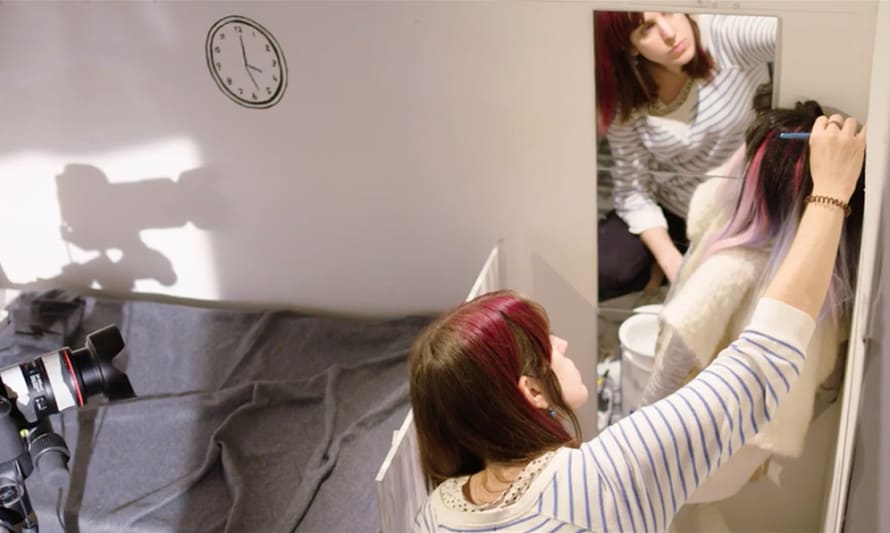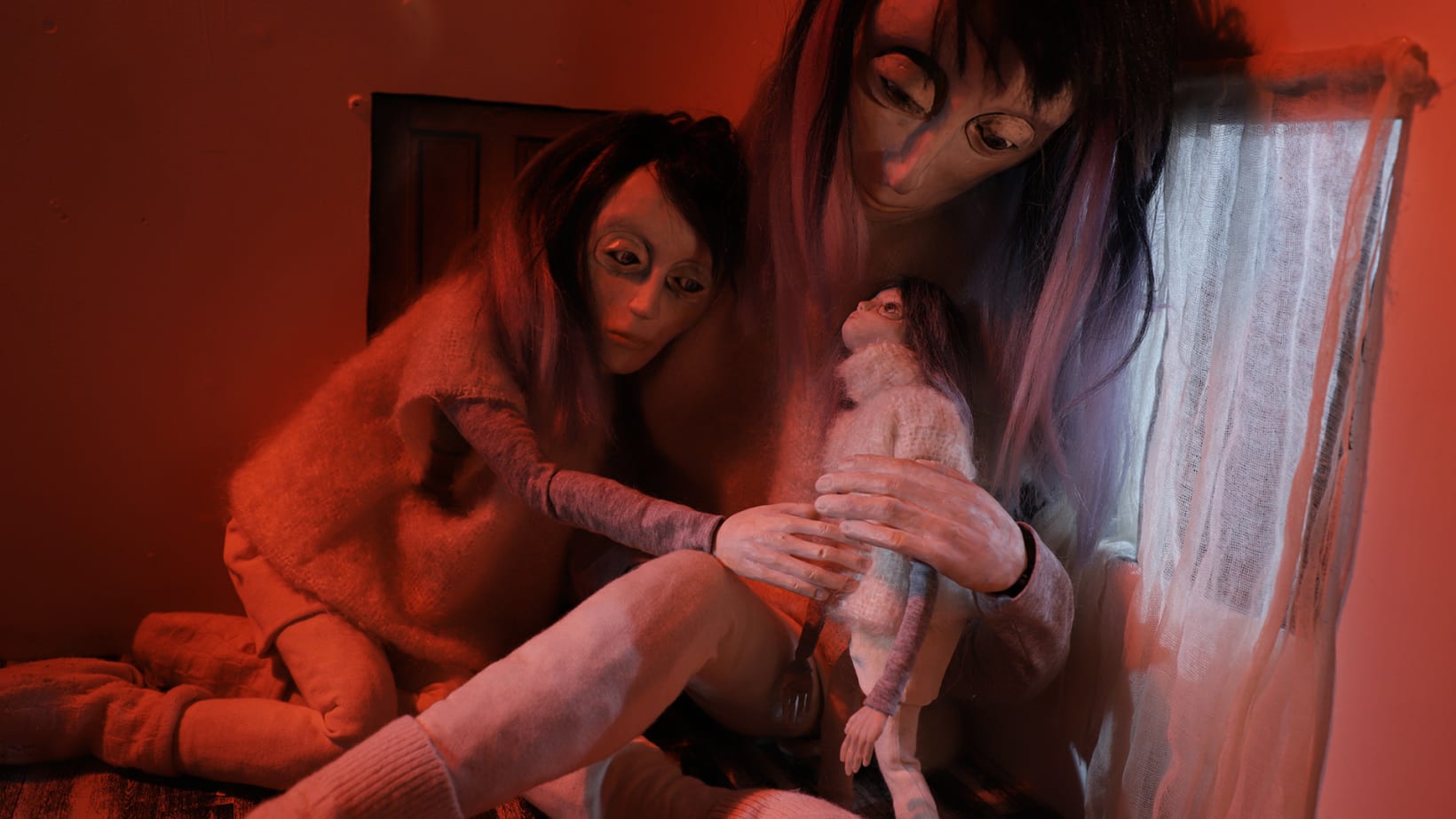
Shadow Passage Interview
Stop-motion animator and RCA student Ali Aschman talks about her film Shadow Passage, automatic writing, and the challenges of puppet animation.
This is a student film. Did you have any artistic or technical constraint?
I had 8 months to make the film, from conception to completion, which was a constraint but quite a generous one. There were no constraints on technique, as the Royal College of Art MA allows students to work any way they choose. Being one of the few students in my cohort working in stop-motion, I had full access to the largest studio which made using such big puppets and sets possible. The RCA's philosophy is to foster the director's unique artistic voice, so we all work independently on our own films, rather than in teams - so the team was just me for most of the production, except for my composer and sound designer (facilitated through RCA partnerships) and costume designers (who were fellow students in the Textiles course). I had a few short-term fabrication and animation assistants during production, but this was very limited. Although this would usually be seen as a constraint for stop motion, which typically requires large teams, it was actually more help than I've ever received, since I've always worked as an independent artist making films and other artworks on zero budget alone in my studio, and making it as an RCA student is what made that possible.
You say the film is improvised. What was the starting point and how did you develop it?
The starting point was the medium - I wanted to make a stop motion film using large puppets and sets, and to combine puppet animation with 2D frame by frame painting or drawing inside the set. In my previous films I've usually used a limited set of materials and colour palette, and I wanted to push myself to take a more mixed-media approach, similar to some of the sculptural work I've made in the past as a visual artist, as well as to use colour in a symbolic way. For the subject matter, I was heavily inspired by a quote from Carl Jung about meeting one's shadow, describing it as "a tight passage, a narrow door". I had these strong images of doors and windows in my mind, as liminal objects separating and connecting rooms in an architecture representing the self, so growing outward from that I developed the structure of the film. Psychotherapy has been an important factor in my life in recent years, and I wanted to visualise some of the discoveries I had made about my own psyche in those sessions. So through research, automatic writing and poetry, and constant notation of my thoughts, I came up with the idea of a series of 3 rooms, that would each represent a different aspect of the same person's psychology. Each successive room decreased in size, as did the puppet inhabiting it, and I knew they should all end up together. So when I started shooting, I had that core structure in place but I hadn't planned anything about how the shot would be set up, where the characters would be placed, how they would move, or how long scenes would be. I didn't make a storyboard or animatic. I just moved around inside the set with the camera, trying out different angles and lighting, and once I found something I liked I just went with it, making up the movements, as I went along. Same for the painted imagery on the walls - I literally improvised on the spot and let one image inspire the next. In this way all the nuances of the narrative were built through the process of making.
Despite a rather dark universe, there is something comforting about the film. Was it something you had anticipated?
This was actually my intention, so I am really glad you read it that way! My last film Body Echo touches on related themes of depression, alienation, and feeling fragmented - but it ends with the character staying dormant in her claustrophobic universe. So for me, the final shot of Shadow Passage, with the small puppet leaving on her own into the unknown is a hopeful image. It was important to me for my own mental health, but also to avoid being repetitive in my oeuvre, to make something a little more open and optimistic. Sarah, the composer, did a wonderful job conveying this with the music. I know some people interpret it differently, as more of a gloomy ending, or even as death, which is also fine, since it's a film about psychology so it makes absolute sense for people to project their own feelings and experiences onto it. One thing that I did not anticipate is the sweetness of the interaction between the three puppets. In my mind, the first one would find the second one crying uncontrollably in the second room, and they would physically fight, representing a conflict between intellect and emotion - however when they came face to face they seemed to naturally connect in a more caring way so I leaned into that. And when all three are together, there was a tenderness that I hadn't quite expected, and it felt like a healing moment.
Where do the projected images at the start come from?
They are all sourced from the Prelinger Archive, an excellent online source for digitised public domain footage from corporate and educational films, and amateur and home movies. I wanted to use the projector as an additional, interesting light source, so I looked for imagery that would work in that way. The projection was also a way of layering images within the space to represent her anxious state of mind. And then with all the train footage, I was thinking about the door that she needs to go through, and how to pull attention towards it, so I was thinking of things that have a forward rushing motion, and relating to the idea of tunnels and passages. I also had a very vivid dream about a person falling/jumping in front of a train, and felt it needed to be in the film somehow.
Can you talk about the work on the music and sound design?
Sarah Playford composed the score, and Kevin Langhamer did the sound design. I had worked with both of them on my previous film Body Echo, so we already had a good working relationship. We worked collaboratively as a team from the very early stages of the project, talking about tone and theme, and then Sarah composed an initial score just from my verbal description of the different rooms, before I'd even shot anything, which helped to define the pacing of the animation. So I was very much inspired by Sarah's vision as much as she was by mine. From there it was a back and forth between the three of us, as I would shoot more animation I'd sent it to them and Sarah would adjust her score and Kevin would play with the layering and add sound effects and foley. At the end we all sat down together for a couple of long mixing sessions to lock the sound.
The film can make us think of Alice in Wonderland (for the narrative) or the Quay Brothers (for the visuals). Did you have any reference in mind?
Yes, the image of giant Alice squashed into the house was definitely a primary reference! I wanted to express the feeling of being trapped within oneself, and in order to escape, rather than shrink down like Alice would, to get through the tiny door, there's another miniature version of oneself that can leave, while other parts must remain. I have always loved fairytales and children's fantasy, and Alice in Wonderland was an important influence from my childhood.
The Quay brothers are my stop motion heroes, and there's a little bit of their influence in almost all my films. The gritty texture of their worlds, the puppets with rigid faces that communicate through subtle bodily gesture, camera movements and sonic atmosphere rather than classic expressive "character animation", and the slow pace of their films are all reference points. I like that they are never trying to convince the viewer that their puppets and sets are anything other than what they are - a collection of fabric scraps, dusty pages, bits of hardware, doll parts and so on - but they reveal the hidden magic within these objects, as opposed to the slick construction of silicon-cast armature puppets and perfectly scaled sets. I tried to embrace this evidence of artifice and construction in my film as well, by making my puppets very puppet-like rather than trying to make them seem human.
Are you working on any new project?
The last year since graduating has been a bit of a rollercoaster, leaving the UK for a period to go back to the US and South Africa, before returning with a new visa so I can live and work here. It's taken me quite a while to get settled and find a job and a place to live, so I put creative work on the back-burner for a while, aside from writing lots of film/project proposals for grants and residencies... and then COVID-19 hit! I've found it difficult to be productive during this time but I am doing a little bit of drawing or sculpture everyday and I'm gearing up to making an animated film in my bedroom. Puppet animation isn't possible in my limited space, so it will be very low-tech, just some pieces of paper on the wall, pencils, a camera and tripod. Animated straight-ahead, Kentridge-style, in a stream-of-consciousness manner, like a daily diary of isolation. I may return to paper cut-outs as well, which I haven't done in a few years. Hopefully by the time this interview is published I'll be well into that!

